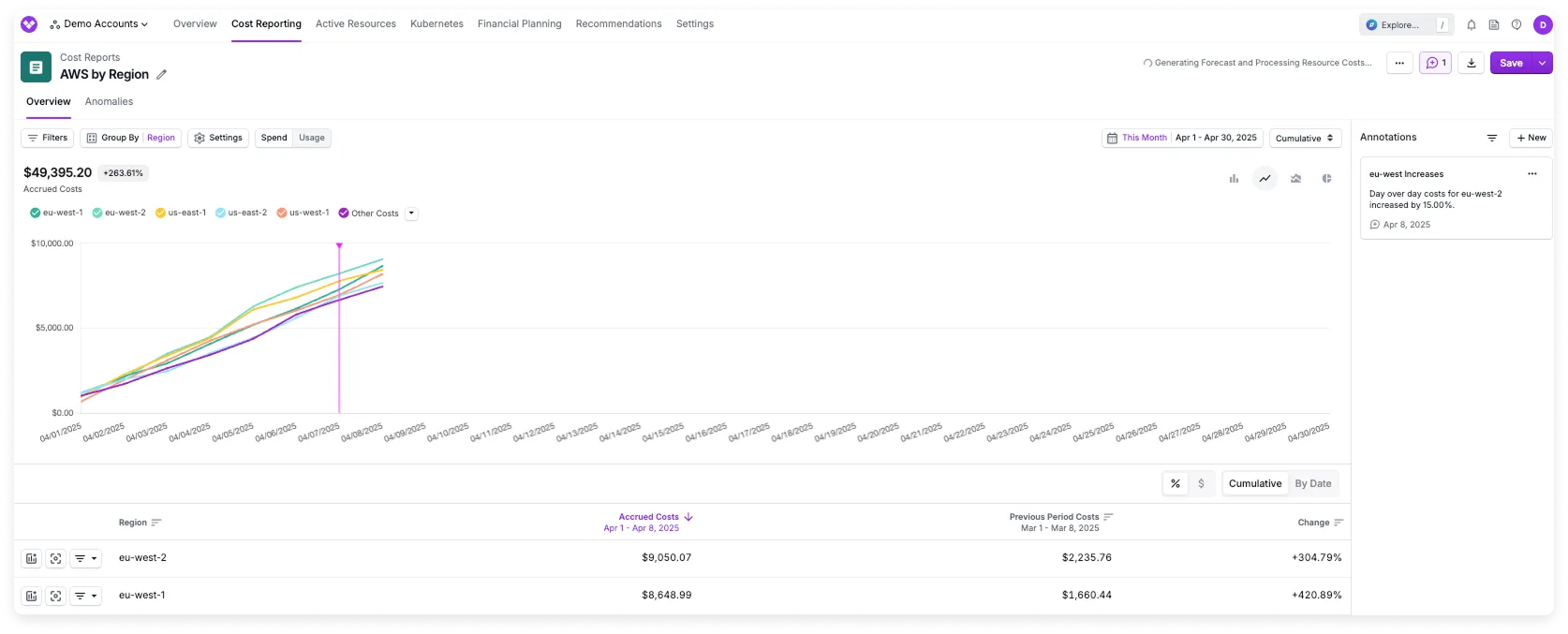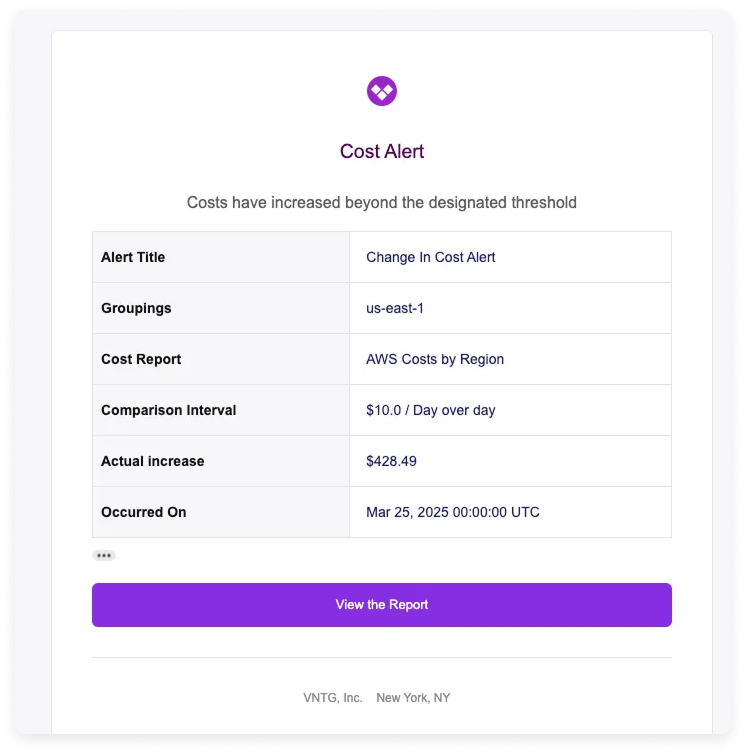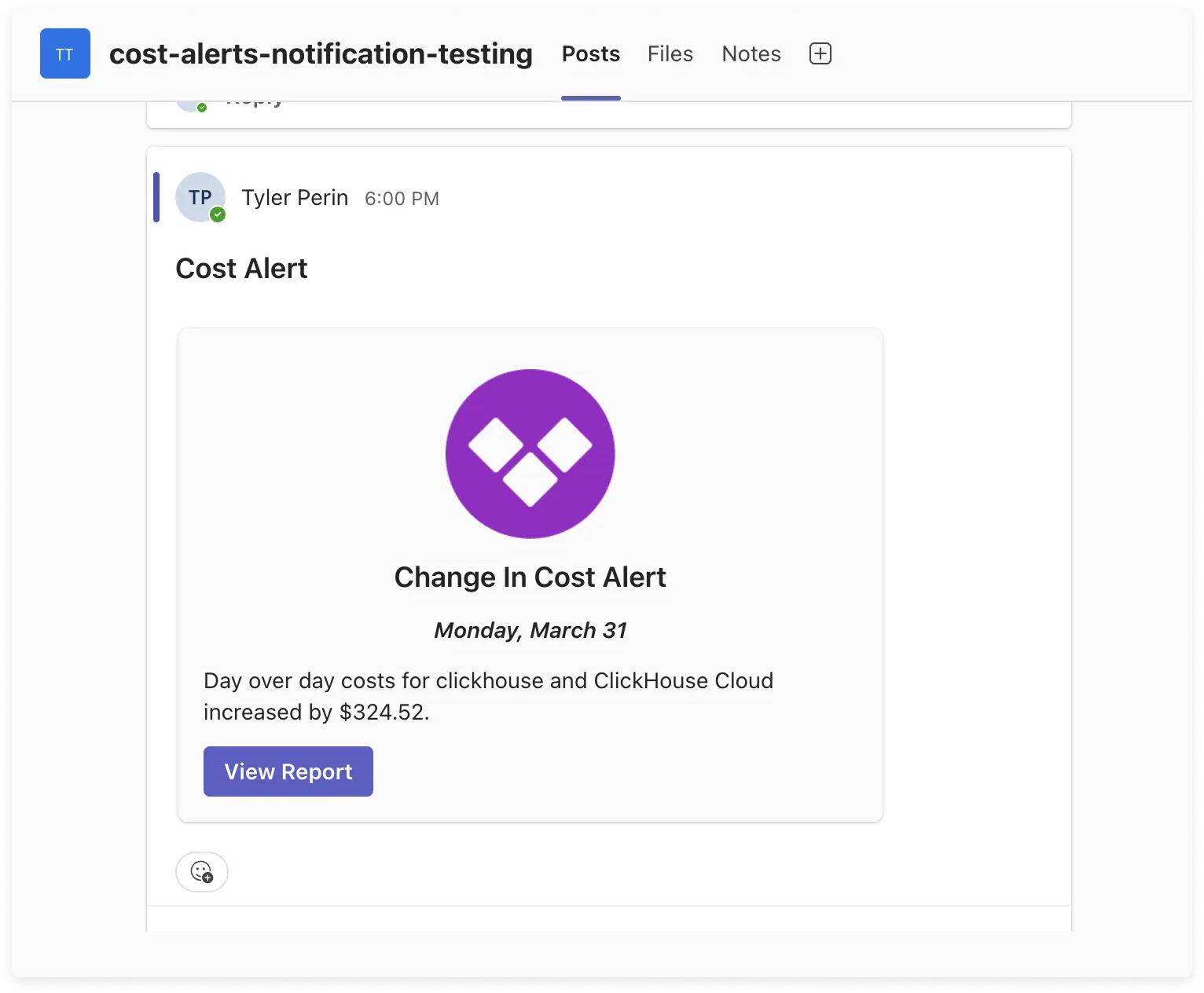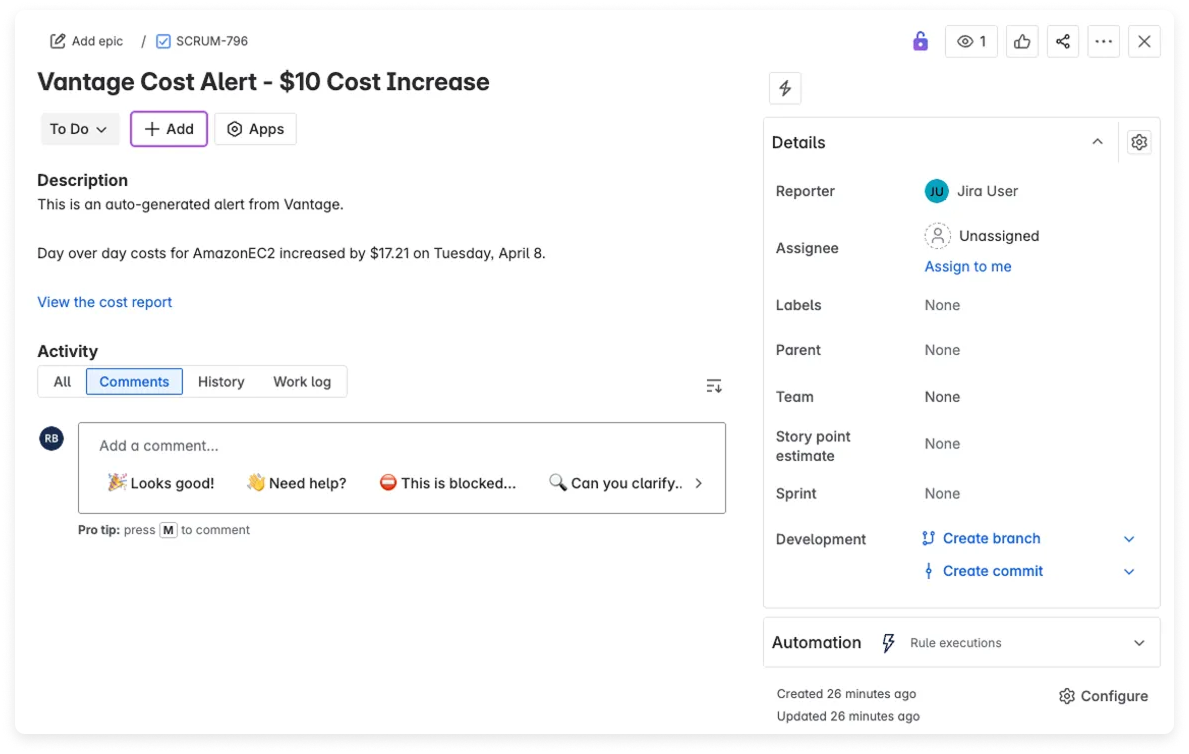If you want to use Slack, Teams, or Jira, you will need to configure the corresponding integration with Vantage. See the Slack, Microsoft Teams, or Jira integration documentation for details. For Slack and Microsoft Teams, you can create either a Slack integration or a Microsoft Teams integration, but not both. Once you have completed the integration steps, complete the below instructions to configure Cost Alerts.
Create a Cost Alert
Cost Alerts can be created in two ways—either directly from a Cost Report or via the Notifications page.- From a Cost Report: From the top right of a report, click the ellipses button (…), then select Create Cost Alert.
- From the Notifications page: Click the bell icon from the top right of the console, which displays the Cost Alerts dashboard, then click Configure Cost Alert.
1
Enter a Title for your alert.
2
For Cost Change Threshold, select % or $ and enter the dollar-based or percentage-based change threshold for the alert.
3
For Comparison Interval, select how you want Vantage to evaluate changes in cost over time. This determines the time periods that will be compared to detect changes. All timestamps of costs are in UTC.
- Day over Day: Compares today’s costs to yesterday’s. Useful for catching sharp, immediate changes.
- Week over Week: Compares the current week (Sunday to Saturday) to the previous one. Ideal for spotting trends in weekly cycles.
- Month over Month: Compares the current month (1st to end of month) to the previous month. Identify longer-term shifts.
- Quarter over Quarter: Compares costs across standard calendar quarters. Useful for high-level budget tracking and executive reporting.
4
Select the Cost Report(s) you want this alert to apply to. You can select up to 10 reports per alert.
If you create the alert from within a Cost Report, that report will be pre-selected here. You can still add up to 9 additional reports.
5
Select your notification preferences:
- Email: Select which Vantage users should receive alert emails.
- Slack or Microsoft Teams: Select the channels where alerts should be posted.
- Jira: Select the appropriate projects and provide any additional details required for issue creation.
- You can choose not to send external notifications. In this case, alerts will only appear as annotations within the selected Cost Reports. See the View Cost Alerts section for details on annotations.
6
Click Save Alert.
View Cost Alerts
Alerts are delivered as soon as Vantage updates the data for the Cost Report associated with your Cost Alert. When a Cost Alert is triggered, Vantage performs two actions:- Sends any configured alerts to configured external services (i.e., email, Slack, Teams, or Jira).
- Adds an annotation directly to the relevant Cost Report, shown in the image below as a pink line on the graph. When you click the line, the Annotations subpanel is displayed on the right with details about the alert. If you delete a Cost Alert or remove a Cost Report from it, any annotations linked to that alert will also be removed from the affected Cost Reports.
If your cost data is retroactively updated by a cloud provider and meets one of your alert criteria, it may trigger a retroactive alert. If an alert has already been created and retroactive cost data causes it to no longer be valid, Vantage will persist the annotation in the Cost Report.
- For example, if a report is grouped by Region, and you’ve set an alert to trigger on day-over-day changes of 15% or more, Vantage will evaluate each region individually.
- If your Cost Report is ungrouped, your Cost Alerts will be indexed based on provider (e.g., Azure) and service (e.g., Azure Storage).
- You will be alerted for new groupings in your Cost Report for any dollar-based Cost Alerts. You will not be alerted for new groupings for percent-based Cost Alerts.

- The alert title
- The grouping that triggered the alert (eu-west-2)
- The change amount (+15%)
- The comparison interval (day over day)
View External Alert Notifications
External alert notifications include details about the alert, such as the Cost Alert title, the grouping that triggered the alert, the comparison interval, and the amount of change. Each notification also includes a direct link to the relevant Cost Report for further investigation.Email Alert
Email Alert

Slack Alert
Slack Alert

MS Teams Alert
MS Teams Alert

Jira Alert
Jira Alert

Best Practices for Cost Alerts
When setting up Cost Alerts, it’s important to configure them in a way that provides meaningful insights. Below is a table outlining common configurations that may lead to a high volume of alerts and suggestions on how to optimize them.| Alert Configuration | Potential Issue | Best-Practice Configuration |
|---|---|---|
| Day-over-day alerts on volatile costs (e.g., on-demand compute costs) | Frequent notifications due to normal fluctuations | Use weekly or monthly evaluation periods instead to track stable trends |
| Connecting alerts to reports that filter on a very broad scope (e.g., all accounts, all services) | Potentially generates excessive alerts for each service or dimension, depending on how often your costs fluctuate | Narrow the scope of the Cost Report to specific accounts, regions, services, or Virtual Tags. Consider using longer-term evaluation periods |
| Low percentage thresholds (e.g., 1–10%) | Small fluctuations can trigger frequent alerts | Set thresholds at >10% to focus on meaningful changes |
| Static dollar thresholds that are too low | Minor cost changes may trigger alerts | Configure alerts for significant cost shifts (e.g., >50) |
Cost Alerts Examples
Cost Alerts are most effective when they help you catch unexpected cost increases or drops before they become budget issues. Below are a few example use cases, along with how to configure your Cost Reports and alerts for each scenario. Consider the following guidance when deciding between a percentage-based or dollar-based alert.| Alert Type | Use Case |
|---|---|
| Percentage-Based Alerts | You’re tracking lower-cost services where changes in spend may still indicate scaling, regressions, or misconfigurations. It can also be useful for automating detection of trends for your spend over longer durations. |
| Dollar-Based Alerts | Small fluctuations in usage could regularly trigger percentage-based alerts without reflecting real concern. Dollar-based thresholds help filter for material, static changes. |
Percentage-Based Alerts
Use percentage-based alerts to spot relative changes in cost. For example, this type of alert can be useful when monitoring lower-spend resources that may not trigger a dollar-based alert, but are still scaling faster than expected. For example, you want to see any monthly percentage-based changes in data transfer, greater than 20%, for a production mobile app. You set up the following Cost Report and corresponding alert:- Cost Report Filters:
- Provider: AWS
- Category = EC2, Data Transfer
- Tags (either from your provider or virtual tags): Environment = Production, Application = Mobile App
- Cost Alert Config:
- Change type = Percentage
- Threshold = 20%
- Comparison Interval = Month over Month
Dollar-Based Alerts
Use dollar-based alerts for high-cost services where even small percentage changes represent substantial spend or where you need to be aware of material spend. For example, your team has a specific quarterly budget for storage. You want to be alerted weekly if S3 Storage increases by $2,000 compared to the previous week. You set up the following Cost Report and corresponding alert:- Cost Report Filters:
- Provider: AWS
- Category = S3, Storage
- Cost Alert Config:
- Change type = Dollar
- Threshold = $2,000
- Comparison Interval = Week over Week